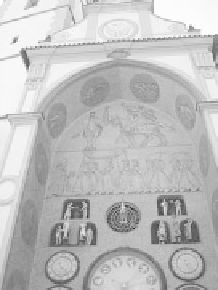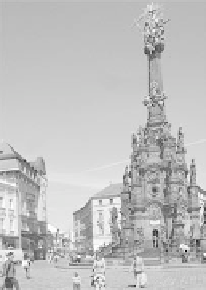Travel Reference
In-Depth Information
at 11:00 and 15:00, book tickets and depart from the TI located
within the Town Hall).
s
Astronomical Clock
—he huge clock on the Town Hall was
once far more complex than even the one in Prague. Originally,
it depicted the medieval universe
divided into three spheres, but it was
periodically rebuilt to correspond
with new advances in knowledge.
In 1898, purists worked to restore
it to its original state. (A picture of
this older version is in the window
located a few steps to the left of the
actual clock.)
Like Prague's clock, Olomouc's
astronomical clock was intentionally
destroyed by the Nazis in World War
II. Today's version was rebuilt in 1953
by the communists—with their kitschy flair for propaganda. In
this one-of-a-kind clock made in the Social Realist style, you have
earnest chemists and heroic mothers rather than saints and Virgin
Marys. High noon is marked by a proletarian parade, when, for
six minutes, a mechanical conga line of milkmaids, clerks, black-
smiths, medics, and teachers are celebrated as the champions of
everyday society. Study the mosaic symbols of the 12 months (
leden
is January; circle down on the left—
červen
is June). The Haná
region is agriculturally rich, so each month features a farm activity.
As with any proper astronomical clock, there's a wheel with 365
saints, so you'll always know whose special day it is. But this clock
comes with a Moscow-inspired bonus—red bands on the wheel
splice in the birthdays of communist leaders (Lenin was born on
the 112th day of the year in 1870; Stalin's saint was Toman—day
355). Note that the clock's designers were optimists—the year
mechanism (on the bottom) is capable of spinning until 9999 a.d.
sss
Column of the Holy Trinity
(Sousoší Nejsvětější Trojice)
—he artis-
tic pride of Olomouc is the tallest plague col-
umn in Europe. Squares throughout Eastern
Europe are dotted with similar structures,
erected by locals to give thanks for surviving
the plague. This one was started in 1716 by a
local man named Render, who announced—
with a confidence characteristic of the Haná
region—that he would create a work that
in “ its height and ornamentation would
not have a peer in terms of excellence.” He
donated his entire fortune, employing many






















